学区房论文
- 格式:doc
- 大小:26.00 KB
- 文档页数:8
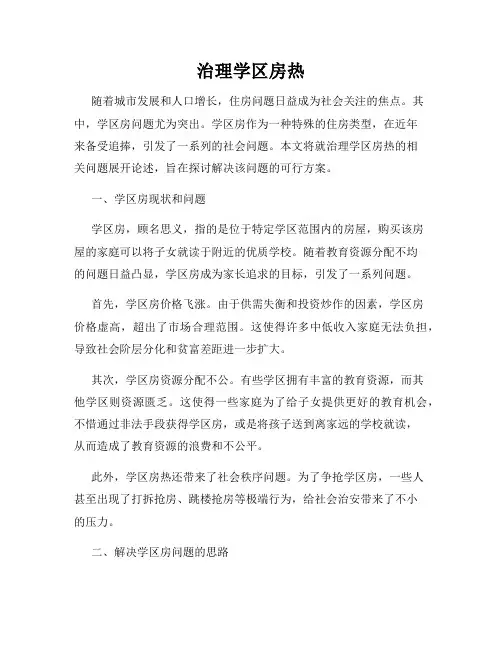
治理学区房热随着城市发展和人口增长,住房问题日益成为社会关注的焦点。
其中,学区房问题尤为突出。
学区房作为一种特殊的住房类型,在近年来备受追捧,引发了一系列的社会问题。
本文将就治理学区房热的相关问题展开论述,旨在探讨解决该问题的可行方案。
一、学区房现状和问题学区房,顾名思义,指的是位于特定学区范围内的房屋,购买该房屋的家庭可以将子女就读于附近的优质学校。
随着教育资源分配不均的问题日益凸显,学区房成为家长追求的目标,引发了一系列问题。
首先,学区房价格飞涨。
由于供需失衡和投资炒作的因素,学区房价格虚高,超出了市场合理范围。
这使得许多中低收入家庭无法负担,导致社会阶层分化和贫富差距进一步扩大。
其次,学区房资源分配不公。
有些学区拥有丰富的教育资源,而其他学区则资源匮乏。
这使得一些家庭为了给子女提供更好的教育机会,不惜通过非法手段获得学区房,或是将孩子送到离家远的学校就读,从而造成了教育资源的浪费和不公平。
此外,学区房热还带来了社会秩序问题。
为了争抢学区房,一些人甚至出现了打拆抢房、跳楼抢房等极端行为,给社会治安带来了不小的压力。
二、解决学区房问题的思路面对学区房问题,需要综合考虑市场机制、政府引导和社会参与等多方面因素,制定出既能平衡供需关系又能保障公平正义的解决方案。
首先,完善住房市场监管机制。
政府应加大对房地产市场的监管力度,打击投机炒作行为,防止学区房价格过度上涨。
同时,建立健全的住房价格评估机制,确保房屋价格公正合理,避免资源浪费和财富积累不均。
其次,优化教育资源配置。
政府应加大对教育资源的投入,提高普通学校的办学水平,使得每所学校都能提供良好的教育质量。
此外,通过推行一体化优质教育,消除学区差异,使得家长对学区房的依赖逐渐降低。
第三,加强公共交通建设。
学区房热的一个重要原因是家长希望孩子能就近上学,因此,政府应加大对公共交通的投资,提升学校周边交通网络的便捷性,降低学区房对校区距离的依赖,减轻学区房的供需压力。
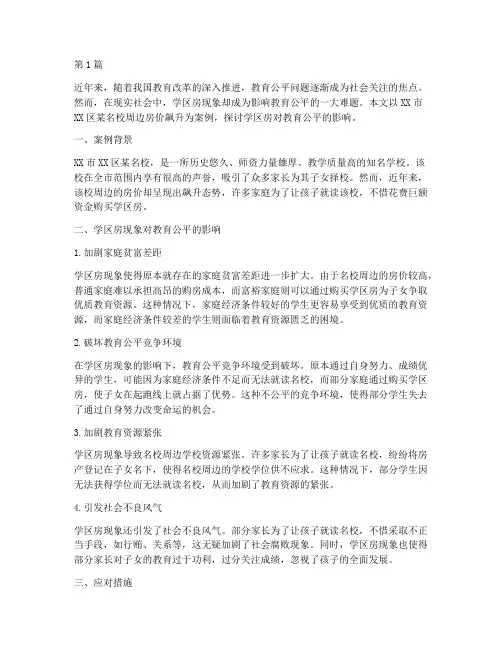
第1篇近年来,随着我国教育改革的深入推进,教育公平问题逐渐成为社会关注的焦点。
然而,在现实社会中,学区房现象却成为影响教育公平的一大难题。
本文以XX市XX区某名校周边房价飙升为案例,探讨学区房对教育公平的影响。
一、案例背景XX市XX区某名校,是一所历史悠久、师资力量雄厚、教学质量高的知名学校。
该校在全市范围内享有很高的声誉,吸引了众多家长为其子女择校。
然而,近年来,该校周边的房价却呈现出飙升态势,许多家庭为了让孩子就读该校,不惜花费巨额资金购买学区房。
二、学区房现象对教育公平的影响1.加剧家庭贫富差距学区房现象使得原本就存在的家庭贫富差距进一步扩大。
由于名校周边的房价较高,普通家庭难以承担高昂的购房成本,而富裕家庭则可以通过购买学区房为子女争取优质教育资源。
这种情况下,家庭经济条件较好的学生更容易享受到优质的教育资源,而家庭经济条件较差的学生则面临着教育资源匮乏的困境。
2.破坏教育公平竞争环境在学区房现象的影响下,教育公平竞争环境受到破坏。
原本通过自身努力、成绩优异的学生,可能因为家庭经济条件不足而无法就读名校,而部分家庭通过购买学区房,使子女在起跑线上就占据了优势。
这种不公平的竞争环境,使得部分学生失去了通过自身努力改变命运的机会。
3.加剧教育资源紧张学区房现象导致名校周边学校资源紧张。
许多家长为了让孩子就读名校,纷纷将房产登记在子女名下,使得名校周边的学校学位供不应求。
这种情况下,部分学生因无法获得学位而无法就读名校,从而加剧了教育资源的紧张。
4.引发社会不良风气学区房现象还引发了社会不良风气。
部分家长为了让孩子就读名校,不惜采取不正当手段,如行贿、关系等,这无疑加剧了社会腐败现象。
同时,学区房现象也使得部分家长对子女的教育过于功利,过分关注成绩,忽视了孩子的全面发展。
三、应对措施1.优化教育资源配置政府应加大对教育资源的投入,合理配置教育资源,提高教育质量。
同时,加强教育信息化建设,实现优质教育资源共享,让更多学生享受到优质教育资源。
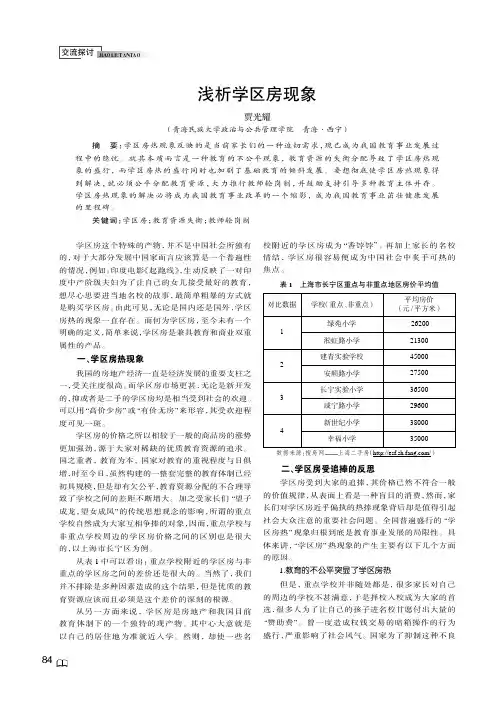
交流探讨浅析学区房现象贾光耀(青海民族大学政治与公共管理学院青海西宁)摘要:学区房热现象反映的是当前家长们的一种迫切需求,现已成为我国教育事业发展过程中的隐忧。
就其本质而言是一种教育的不公平现象,教育资源的失衡分配导致了学区房热现象的盛行,而学区房热的盛行同时也加剧了基础教育的倾斜发展。
要想彻底使学区房热现象得到解决,就必须公平分配教育资源,大力推行教师轮岗制,并鼓励支持引导多种教育主体并存。
学区房热现象的解决必将成为我国教育事业改革的一个缩影,成为我国教育事业茁壮健康发展的里程碑。
关键词:学区房;教育资源失衡;教师轮岗制学区房这个特殊的产物,并不是中国社会所独有的,对于大部分发展中国家而言应该算是一个普遍性的情况,例如:印度电影《起跑线》,生动反映了一对印度中产阶级夫妇为了让自己的女儿接受最好的教育,想尽心思要进当地名校的故事,最简单粗暴的方式就是购买学区房。
由此可见,无论是国内还是国外,学区房热的现象一直存在。
而何为学区房,至今未有一个明确的定义,简单来说,学区房是兼具教育和商业双重属性的产品。
一、学区房热现象我国的房地产经济一直是经济发展的重要支柱之一,受关注度很高。
而学区房市场更甚,无论是新开发的,抑或者是二手的学区房均是相当受到社会的欢迎。
可以用高价少房或有价无房来形容,其受欢迎程度可见一斑。
学区房的价格之所以相较于一般的商品房的涨势更加强劲,源于大家对稀缺的优质教育资源的追求。
国之重者,教育为本,国家对教育的重视程度与日俱增,时至今日,虽然构建的一整套完整的教育体制已经初具规模,但是却有欠公平,教育资源分配的不合理导致了学校之间的差距不断增大。
加之受家长们望子成龙,望女成凤的传统思想观念的影响,所谓的重点学校自然成为大家互相争捧的对象,因而,重点学校与非重点学校周边的学区房价格之间的区别也是很大的,以上海市长宁区为例。
从表1中可以看出:重点学校附近的学区房与非重点的学区房之间的差价还是很大的。

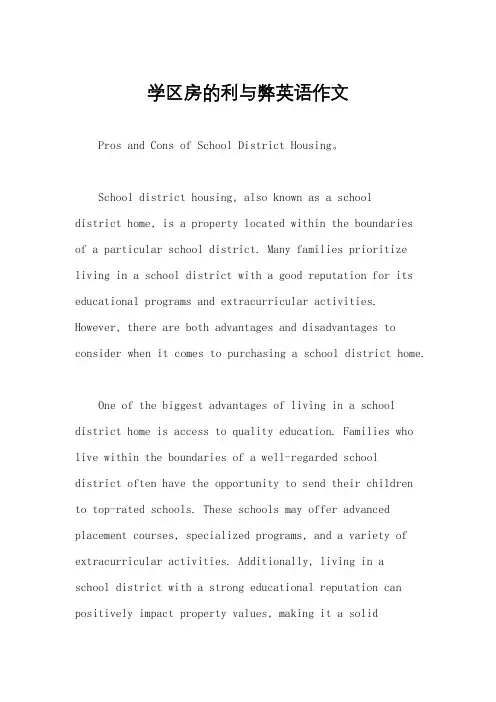
学区房的利与弊英语作文Pros and Cons of School District Housing。
School district housing, also known as a schooldistrict home, is a property located within the boundariesof a particular school district. Many families prioritize living in a school district with a good reputation for its educational programs and extracurricular activities. However, there are both advantages and disadvantages to consider when it comes to purchasing a school district home.One of the biggest advantages of living in a school district home is access to quality education. Families who live within the boundaries of a well-regarded schooldistrict often have the opportunity to send their childrento top-rated schools. These schools may offer advanced placement courses, specialized programs, and a variety of extracurricular activities. Additionally, living in aschool district with a strong educational reputation can positively impact property values, making it a solidinvestment for the future.Another advantage of school district housing is the sense of community. Families who live in the same school district often share similar values and priorities when it comes to education. This can lead to a strong sense of community and support among neighbors, as well as opportunities for children to form lasting friendships with their peers.However, there are also drawbacks to consider when it comes to school district housing. One of the main disadvantages is the cost. Homes located within desirable school districts often come with a higher price tag, making them less affordable for some families. Additionally, property taxes in these areas may be higher in order to fund the local schools, adding to the overall cost of living.Another potential downside of school district housing is the lack of diversity. In some cases, families may choose to live in a specific school district in order to besurrounded by people of a similar socio-economic status or cultural background. This can lead to a lack of diversity within the community, which may not provide children with a well-rounded view of the world.In conclusion, school district housing offers many benefits, such as access to quality education and a strong sense of community. However, it also comes with drawbacks, including higher costs and potential lack of diversity. Ultimately, the decision to purchase a school district home should be carefully considered based on individualpriorities and financial circumstances.。

“学区房热”的原因及外溢效应研究通过走访各大房地产公司和淮安市房管局,总结淮安房地产现状,以学区房为研究对象,结合微观经济学探析了“学区房热”产生的主要原因是需求过于旺盛,研究“学区房热”不仅导致教育资源配置不公平,形成城市的“藩篱”和消费挤兑现象,还给社会的和谐稳定带来负面影响,最后得出结论并提出相应建议。
一、“学区房热”现象自1998年以来,我国房地产迅速发展,对GDP增长的贡献率比重基本保持在18%,房地产投资在GDP中的比重不断上升,2007年房地产增加值占当年GDP总额约10%。
2008年,我国房地产业受到宏观政策积累效应和金融危机效应的双重打击,呈现市场交易量萎缩,价格增幅放缓,资金链条偏紧的局面。
其中,成交量不足是最大的问题。
以淮安市为例,2008年,淮安共成交商品住宅2401套,与去年相比减少1122套,同比降幅54.17%。
在淮安楼市持续低迷的时候,学区房市场却可以用“高价少房”或“有价无房”来形容,热度不但丝毫不减,还有越演越烈之势。
关于学区房,至今政府和学术界都没有一个统一的定义,大部分人的理解是“名牌中小学周边能够对口入学的住宅”。
从业内角度来看,“学区房”这3个字特指重点小学周边的房子。
本文所指的“学区房”是指位于被当地教育局划分为名牌小学学区内,能够对口入学的住房。
以淮安市为例,从学区房成交量上来看,据调查报告显示,2007年二手学区房的成交量仅占5-8%,进入2008年后,成交量翻两番,高达10-15%。
2009年1-3月,二手学区房单月成交量继续同比增长10-15%,每月售出60-70套,仅1-3月就售出200多套,相对于2008年总销售量600套而言,有明显增幅。
从价格上来看,淮安市实验小学、淮安师范学院附属小学、淮安市长征小学是淮安市民口中的“三大名校”,就我对2008、2009年4月价格涨幅情况调查来看,3所重点小学的学区房价格较非学区房价格平均要高500元—1000元/m2左右,即使在2009年房价普遍下跌4.9%情况下,4月份学区房价格还是稳中有升。
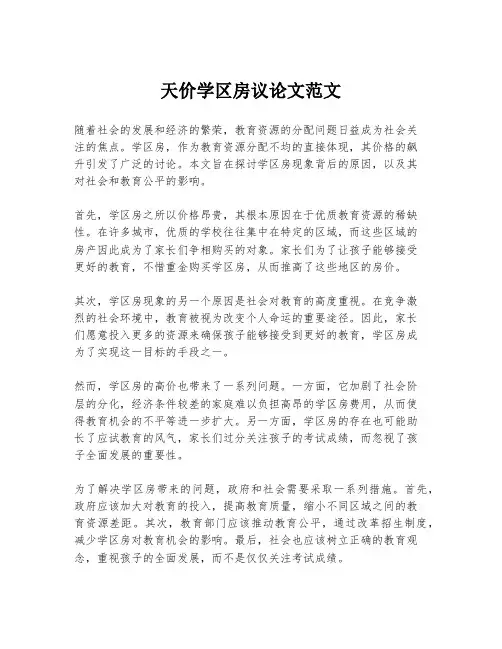
天价学区房议论文范文随着社会的发展和经济的繁荣,教育资源的分配问题日益成为社会关注的焦点。
学区房,作为教育资源分配不均的直接体现,其价格的飙升引发了广泛的讨论。
本文旨在探讨学区房现象背后的原因,以及其对社会和教育公平的影响。
首先,学区房之所以价格昂贵,其根本原因在于优质教育资源的稀缺性。
在许多城市,优质的学校往往集中在特定的区域,而这些区域的房产因此成为了家长们争相购买的对象。
家长们为了让孩子能够接受更好的教育,不惜重金购买学区房,从而推高了这些地区的房价。
其次,学区房现象的另一个原因是社会对教育的高度重视。
在竞争激烈的社会环境中,教育被视为改变个人命运的重要途径。
因此,家长们愿意投入更多的资源来确保孩子能够接受到更好的教育,学区房成为了实现这一目标的手段之一。
然而,学区房的高价也带来了一系列问题。
一方面,它加剧了社会阶层的分化,经济条件较差的家庭难以负担高昂的学区房费用,从而使得教育机会的不平等进一步扩大。
另一方面,学区房的存在也可能助长了应试教育的风气,家长们过分关注孩子的考试成绩,而忽视了孩子全面发展的重要性。
为了解决学区房带来的问题,政府和社会需要采取一系列措施。
首先,政府应该加大对教育的投入,提高教育质量,缩小不同区域之间的教育资源差距。
其次,教育部门应该推动教育公平,通过改革招生制度,减少学区房对教育机会的影响。
最后,社会也应该树立正确的教育观念,重视孩子的全面发展,而不是仅仅关注考试成绩。
总之,学区房现象是教育资源分配不均和家长对孩子教育的高度重视共同作用的结果。
要解决这一问题,需要政府、社会和家长共同努力,推动教育公平,实现教育资源的均衡分配。
只有这样,我们才能为每一个孩子创造一个公平的教育环境,让他们都能够在健康、快乐的氛围中成长。
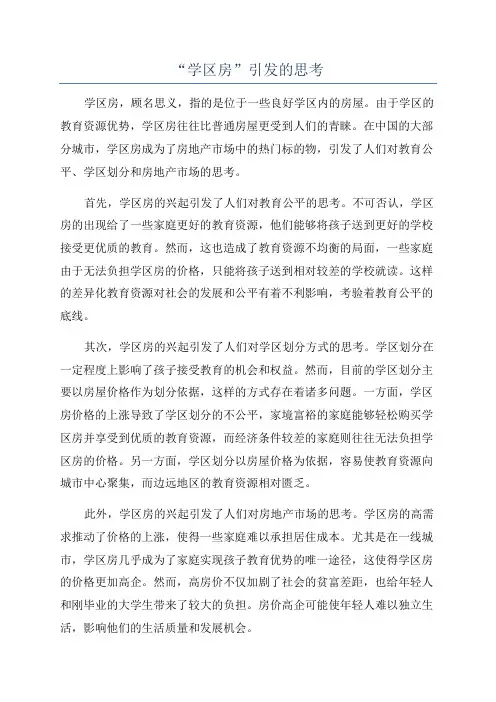
“学区房”引发的思考学区房,顾名思义,指的是位于一些良好学区内的房屋。
由于学区的教育资源优势,学区房往往比普通房屋更受到人们的青睐。
在中国的大部分城市,学区房成为了房地产市场中的热门标的物,引发了人们对教育公平、学区划分和房地产市场的思考。
首先,学区房的兴起引发了人们对教育公平的思考。
不可否认,学区房的出现给了一些家庭更好的教育资源,他们能够将孩子送到更好的学校接受更优质的教育。
然而,这也造成了教育资源不均衡的局面,一些家庭由于无法负担学区房的价格,只能将孩子送到相对较差的学校就读。
这样的差异化教育资源对社会的发展和公平有着不利影响,考验着教育公平的底线。
其次,学区房的兴起引发了人们对学区划分方式的思考。
学区划分在一定程度上影响了孩子接受教育的机会和权益。
然而,目前的学区划分主要以房屋价格作为划分依据,这样的方式存在着诸多问题。
一方面,学区房价格的上涨导致了学区划分的不公平,家境富裕的家庭能够轻松购买学区房并享受到优质的教育资源,而经济条件较差的家庭则往往无法负担学区房的价格。
另一方面,学区划分以房屋价格为依据,容易使教育资源向城市中心聚集,而边远地区的教育资源相对匮乏。
此外,学区房的兴起引发了人们对房地产市场的思考。
学区房的高需求推动了价格的上涨,使得一些家庭难以承担居住成本。
尤其是在一线城市,学区房几乎成为了家庭实现孩子教育优势的唯一途径,这使得学区房的价格更加高企。
然而,高房价不仅加剧了社会的贫富差距,也给年轻人和刚毕业的大学生带来了较大的负担。
房价高企可能使年轻人难以独立生活,影响他们的生活质量和发展机会。
面对学区房引发的思考,我们应该积极采取行动。
首先,政府应该优化教育资源配置,提升公办学校的教学质量,减少对学区房的过分依赖。
政府可以加大对学校的投入,改善基础设施和教师待遇,提高学校整体教育水平,从根本上解决教育资源不均衡问题。
其次,学区划分应该更加公正合理,不能仅以房屋价格作为唯一划分依据。
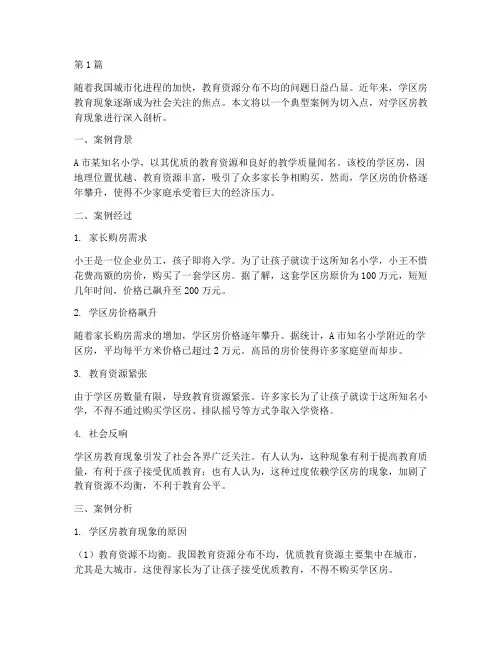
第1篇随着我国城市化进程的加快,教育资源分布不均的问题日益凸显。
近年来,学区房教育现象逐渐成为社会关注的焦点。
本文将以一个典型案例为切入点,对学区房教育现象进行深入剖析。
一、案例背景A市某知名小学,以其优质的教育资源和良好的教学质量闻名。
该校的学区房,因地理位置优越、教育资源丰富,吸引了众多家长争相购买。
然而,学区房的价格逐年攀升,使得不少家庭承受着巨大的经济压力。
二、案例经过1. 家长购房需求小王是一位企业员工,孩子即将入学。
为了让孩子就读于这所知名小学,小王不惜花费高额的房价,购买了一套学区房。
据了解,这套学区房原价为100万元,短短几年时间,价格已飙升至200万元。
2. 学区房价格飙升随着家长购房需求的增加,学区房价格逐年攀升。
据统计,A市知名小学附近的学区房,平均每平方米价格已超过2万元。
高昂的房价使得许多家庭望而却步。
3. 教育资源紧张由于学区房数量有限,导致教育资源紧张。
许多家长为了让孩子就读于这所知名小学,不得不通过购买学区房、排队摇号等方式争取入学资格。
4. 社会反响学区房教育现象引发了社会各界广泛关注。
有人认为,这种现象有利于提高教育质量,有利于孩子接受优质教育;也有人认为,这种过度依赖学区房的现象,加剧了教育资源不均衡,不利于教育公平。
三、案例分析1. 学区房教育现象的原因(1)教育资源不均衡。
我国教育资源分布不均,优质教育资源主要集中在城市,尤其是大城市。
这使得家长为了让孩子接受优质教育,不得不购买学区房。
(2)房价上涨。
近年来,我国房价持续上涨,尤其是学区房。
家长为了让孩子就读于优质学校,不得不承受高昂的房价。
(3)教育竞争激烈。
随着社会竞争的加剧,家长越来越重视孩子的教育。
为了让孩子在竞争中脱颖而出,他们愿意付出更多代价。
2. 学区房教育现象的影响(1)加剧教育资源不均衡。
学区房教育现象使得优质教育资源更加集中在城市,加剧了教育资源的不均衡。
(2)影响教育公平。
学区房价格高昂,使得部分家庭无法承担,从而影响教育公平。

作文,关于天价学区房作文,不少于1000字小区的门口不知什么时候突然多了几堆金字塔似的沙子。
这下可把我们几个小孩给乐坏了,从此金字塔里充满了欢声笑语,金字塔简直成了我们乐园。
每到星期六。
我们就会不约而同地来到金字塔玩造房子。
我们在花坛里找了些金黄的落叶、一些小石子,还有一些飘落在四周的各种五彩花瓣。
我在金字塔上造起了一幢幢的高楼,又把落叶插在沙中化成一株株小树苗,那五彩的花瓣也在我的手中重获新生再次绽放在我的花园中。
看着亲手建造的高楼,开心地想:有付出就会有收获;有汗水,就会有成功。
回头看同伴们的房子,只见她用沙子堆了许多大大小小的山,山前是用沙子堆起来的一座两层楼的房子,房子的四周是用小石子做篱笆,篱笆外面又是用一片片落叶做成的小树林,在沙地上写着:小柳树和小枣树。
沙地上还飘落着一些又大又红的枣子,啊!好一个温馨小院。
她给小院取名为美丽的老家。
而我的高楼也早在我心中有了她的称呼--美丽的柯桥。
天价学区房的利与弊作文800字现在80、90后的年轻人全在想尽办法去挣钱去买那一套套价格直线上升的房子,互相之间询问:“你家买多少钱?”他们认为家是一栋房子。
其实家不等于房子,而家也不小于房子,家大于房子,但是有人会问那“房子+?=家”呢?我就用一个事例告诉你。
在美国洛杉矶,警察发现一个喝醉了的男士。
他扶起醉汉,一看,原来醉汉是当地的大富翁,正当警察说送他回家时,富翁一脸茫然地问道:“家,我没有家呀。
”警察以为富翁是因为喝醉了才这么说的,于是,他指着远处富翁富丽堂皇的别墅问富翁:“那是什么,不是你的家吗?”“不,他只是我的房子。
”富翁说道。
原来,富翁的亲人们都陆陆续续搬走了,缺少了那份幸福与温馨,他觉得,缺少亲情的地方不是家。
1983年,一个发生在卢旺达的真实故事更能给家一个贴切的注释。
卢旺达内战期间,有一个叫热拉尔的37岁男人,他的家人中父母、兄弟姐妹、妻儿几乎全部丧生。
他万分绝望,但是当他打听到他5岁的女儿还活着时,他就开始冒着生命危险,寻找他那唯一的亲人,终于,他费尽千辛万苦找到了女儿,在拥抱着女儿时,他说:“我又有家了!”家应该是一个充满亲情和爱的地方,而不是或精致,或简陋,或大,或小的房子,所以,我想对天下所有人说:“请不要把一栋富丽堂皇却没有亲人的地方称作“家”…”天价学区房作文怎么写一名京城白领,因为买不起天价学区房便决定移民他国,下定决心后写了《再见北京》流布网络,引发了一波不大不小的舆情。

学区房发展对学生教育的影响研究第一章:前言学区房指的是一些特定地区的房产,这些房产是在学校规定的辖区内,某些学生可以申请进入该区域的学校就读。
学区房在房产市场上一直备受瞩目,因为它们与学生教育的关系密不可分。
在这篇文章中,我们将探讨学区房发展对学生教育的影响。
第二章:学区房对教育的影响2.1 学区房带来的优势学区房最显著的优势之一就是其靠近学校的位置。
学区房可以让家长在孩子就读的学校附近买房,这将减少学生所需的交通时间和成本,同时方便家长在孩子完成学校任务后接送孩子。
此外,居住在学区房的学生可以加入学校附属俱乐部、运动队或其他特别活动,这些活动能够提高学生的奉献精神、领导能力和协作能力。
2.2 学区房的挑战学区房的价格较高,因为房产买家会为了孩子的教育而愿意支付更高的价格。
这将使得很多家庭无法承受学区房价格,进而导致一些学生不得不去住在远离学校的地方或者选择去其他学校就读。
此外,学区房常常会带来一定的居住区划问题。
如果一个学区房区域内的孩子人口超过了学校的容量,那些住在该地区的孩子可能会不得不去其他学校就读。
这种情况会导致不少家庭对学区房的观念发生变化。
第三章:学区房的社会影响3.1 学区房的文化影响居住在学区房内的人通常与学校有紧密联系。
这会带来一定的社会影响,例如房地产市场会受到学校带来的积极影响。
很多家庭会在孩子学校圈中寻找房屋。
因此,学区房通常会成为房产市场稳定的代表,也为此带来了许多经济收益。
3.2 学区房的社会问题学区房带来的定居与短暂住房问题也会带来一些社会问题。
例如,学区房会带来社会割裂隐患。
因为住在学区房内的学生和其他孩子之间的联系较少。
另外,一些家长选择住在学区房内的房子而不是购买更便宜的房屋是因为学校保密,家长无法得知学校周围的全部情况。
所以,学区房是否朝着为学生提供更好的教育服务的目标前进,还是只是为了安全就犹未可知。
第四章:学区房未来的发展未来,学区房的发展还有很多可以预见的因素。
学区房范本学区房,顾名思义,就是位于教育资源丰富的学区之内的房屋。
在中国的房地产市场上,学区房一直备受关注,因为它代表着教育资源的优势和升值潜力。
那么,学区房究竟是怎样的一种房产呢?首先,学区房的地理位置非常重要。
学区房通常位于教育资源丰富的地区,比如一流的中小学,以及大学、培训机构等。
这样一来,孩子们在就读期间就能够享受到高质量的教育资源,为他们的未来发展奠定坚实的基础。
与此同时,学区房的地理位置也决定了它的升值潜力。
毕竟,一流的教育资源吸引了很多人前来就近居住,从而推动了房价的上涨。
其次,学区房的房屋品质也非常重要。
学区房通常是高品质的住宅小区,有着绿化良好、环境优美的特点。
这样的居住环境不仅能够提供舒适的生活条件,还能够为孩子们提供一个安全、健康的成长环境。
此外,学区房的房屋结构也十分重要。
一个精心设计的学区房,不仅能够满足居民的生活需求,还能够提供良好的学习和休息空间,为孩子们的学习提供便利。
最后,学区房的价值是不可忽视的。
因为学区房所处的地理位置和房屋品质,使得它在市场上的价值相对较高。
无论是自住还是投资,都能够获得稳定的收益。
而且,学区房在未来的升值空间也是非常大的。
由于教育资源的稀缺性,学区房的需求量始终大于供应量,这就保证了学区房的升值潜力。
因此,购买学区房不仅能够享受高品质的教育资源,还能够获得较高的投资回报。
综上所述,学区房不仅是一种房产,更是一种教育资源的体现。
它的地理位置决定了它的教育优势和升值潜力,房屋品质决定了它的舒适度和生活质量,而其价值则体现在教育资源供需的矛盾和市场的升值潜力上。
对于购买学区房的人来说,不仅能够为孩子提供良好的教育环境,还能够获得较高的投资回报。
学区房英语作文Living in a school district can be both a blessing and a curse. On one hand, you have access to top-notch schools with great resources and teachers. On the other hand, you have to deal with the pressure of making sure your kids get into the best schools and maintain high grades.School district boundaries can be a source of contention among parents. Some will do anything to ensure their children are in the right district, even if it means stretching their budget to buy a more expensive house. Others may feel resentful that their kids are not getting the same opportunities as those in the coveted district.The competition to get into a good school district can be fierce. Parents may resort to all kinds of tactics to secure a spot, from attending open houses to schmoozing with school officials. It can become a full-time job just trying to navigate the complex system of school enrollment.For some families, the decision to buy a house in a specific school district is a no-brainer. They see it as an investment in their children's future, ensuring they have access to the best education possible. For others, it may feel like a burden, adding extra stress and financialstrain to their lives.In the end, living in a school district is just one factor among many that can impact a child's education. While it can provide opportunities and advantages, it is not the only path to success. Parents should remember that their love, support, and involvement in their child's education are what truly make a difference.。
有关学区房利弊的英语作文Living in a school district can be both a blessing and a curse. On one hand, it ensures that your children have access to a good education and are surrounded by other kids their age. However, it also means that you may have to pay a premium for housing and deal with the stress of competition to get into the best schools.School district housing can be a great investment for the future. The value of your home is often tied to the quality of the schools in the area, so living in a good school district can increase the resale value of your property. This can be a huge advantage if you plan to sell your home in the future.On the other hand, living in a school district can also be a financial burden. Homes in good school districts are often more expensive, which can make it difficult for some families to afford to live there. This can lead tofinancial strain and may force families to live beyondtheir means in order to provide their children with a good education.In addition to the financial aspect, living in a school district can also be stressful for parents and children alike. The pressure to get into a good school can be overwhelming, and the competition can be fierce. This can create a high-stress environment for both parents and children, and may not be worth the benefits of living in a good school district.Furthermore, living in a school district can also limit your options. You may feel pressured to stay in the same area even if you would prefer to move elsewhere. This can be restrictive and may prevent you from exploring other opportunities or living in a place that better suits your lifestyle.In conclusion, while living in a school district can provide access to a good education and increase the value of your home, it can also be a financial burden, cause stress, and limit your options. It's important to carefullyconsider the pros and cons before making the decision to live in a school district.。
有关学区房的建议英语作文Title: The Importance of School Districts in RealEstate Decision Making。
In recent years, the concept of school districts has become increasingly significant in the realm of real estate. For many families, the quality of schools in a particular area can be a crucial factor when deciding where to buy or rent a home. This essay will explore the reasons why school districts matter in real estate decision making and provide some recommendations for those navigating this aspect ofthe housing market.First and foremost, the quality of education providedby schools within a district directly impacts property values. Research consistently shows that homes located in areas with highly-rated schools tend to command higherprices than those in districts with lower-performing schools. This phenomenon is largely driven by demand: families are often willing to pay a premium to live inareas where their children can access excellent educational opportunities. Thus, investing in a home within a desirable school district can be seen as a wise financial decision,as it may yield greater returns in the long run.Furthermore, school districts can influence the overall desirability of a neighborhood or community. Beyond academic achievement, schools often serve as focal pointsfor social and recreational activities, contributing to a sense of community cohesion. Families are drawn to areas where they feel their children can thrive not only academically but also socially and emotionally. As a result, neighborhoods served by top-performing schools may experience higher demand from prospective buyers or renters, leading to increased competition for available properties.Moreover, the quality of schools can have significant implications for a child's future success and well-being. Access to a high-quality education can open doors to better opportunities and improve outcomes later in life. Parents are naturally motivated to provide the best possible educational environment for their children, and living in adistrict with excellent schools is one way to achieve this goal. By prioritizing education when choosing a place to live, families can set their children on a path toward academic achievement and personal growth.Given the importance of school districts in real estate decision making, it's essential for homebuyers and rentersto conduct thorough research before making a commitment. Here are some recommendations for navigating the school district aspect of the housing market:1. Research School Performance: Take the time to investigate the academic performance and reputation of schools within different districts. Online resources, such as school district websites and education-focused platforms, can provide valuable insights into factors such as test scores, graduation rates, and extracurricular offerings.2. Consider Long-Term Goals: Think about your family's long-term goals and priorities when evaluating school districts. Consider factors such as the age of your children, their educational needs, and your plans for thefuture. Choosing a district that aligns with your family's values and aspirations can lead to greater satisfaction with your housing decision.3. Visit Schools and Neighborhoods: If possible, visit schools and explore neighborhoods firsthand to get a sense of the environment and community atmosphere. Attend open houses, tour school facilities, and talk to local residents to gather firsthand impressions of the area.4. Consult with Real Estate Professionals: Work with experienced real estate agents who are knowledgeable about the local market and school districts. They can provide valuable guidance and help you identify neighborhoods that meet your criteria.5. Be Flexible: While school districts are an important consideration, they should not be the sole determining factor in your housing decision. Keep an open mind and consider other aspects of a neighborhood, such as proximity to amenities, safety, and overall quality of life.In conclusion, school districts play a significant role in real estate decision making, impacting property values, community desirability, and educational outcomes. By prioritizing education and conducting thorough research, homebuyers and renters can make informed choices that align with their family's needs and goals. Choosing a home in a desirable school district can provide both financial and personal benefits, setting the stage for a fulfilling and successful future.。
摘要:论述学区房的定义与产生原因,以及全国学区房的总体状况,同时简单介绍北京及上海等具有代表性的一线城市的学区房状况。
重点实地调查和论述淮安市青浦区的学区房状况,其中以清浦区的新淮中为中心取得学区房的数据及资料,对这些资料进行归类和分析。
同时针对我国特有的学区房现象进行思考,分析其出现的深层原因,以及其对城市房地产经济发展的影响。
最后,尝试预测学区房未来发展方向和解决的方法。
关键词:学区房,教育,淮安,清浦区,发展Abstract:This paper summarizes the definitions and causes of the education house and the general conditions of the education house.Simple introduction of cities such as Beijing and Shanghai education house situation,a survey of our school education condition. Located huaian.One QingPu regional to obtain information center.Considering the peculiar phenomenon of school in China。
Analysis of the deep reasons,to put forward the methods to solve the problems.Keywords:education house, education,Huaian, QingPu regional,development目录1 前言 (4)2 学区房的的定义与产生原因 (4)3 全国学区房与一线城市学区房状况 (5)3.1 北京学区房概况 (5)3.2 上海学区房概况 (6)4 淮安房地产与教育现状简析 (6)4.1 淮安地理区位 (6)4.2 淮安房地产发展趋势 (7)4.3 淮安教育水平及入学政策 (7)5 淮安青浦区学区房现象调查与分析 (8)5.1 清浦区房地产发展状况 (8)5.2 清浦区学校和居民状况 (8)5.3 购房者购买住房的原因 (9)5.4 购房者选择的户型 (9)5.5 子女升学后房产处理方式与学校对房价辐射作用 (9)6 对策与建议 (10)结论 (11)参考文献 (12)致谢 (13)1 前言近年来,我国房地产市场发展极其迅速,虽然在发展过程中经历过不少波折,但是房地产发展的总体趋势是向前的,而在我国的房地产市场中,有一种独特的现象:学区房。
学区房的英语作文Title: The Significance of School Districts in Education。
In the realm of education, one significant aspect that often garners attention and discussion is the concept of school districts, especially in regions where they play a pivotal role in shaping the educational landscape. In this essay, we will delve into the importance of school districts, their impact on students and communities, and the implications they have on education.First and foremost, it's crucial to understand what a school district entails. A school district is a geographical area that is legally bound to operate and maintain public schools. These districts are responsiblefor providing educational services to the students residing within their boundaries. The significance of schooldistricts lies in their ability to ensure equitable access to education, allocate resources efficiently, and foster asense of community within their jurisdiction.One of the primary functions of school districts is to ensure equitable access to education for all students, regardless of their socioeconomic background or geographical location. By dividing regions into smaller, manageable units, school districts can tailor educational programs and services to meet the diverse needs of their student populations. This targeted approach helps address disparities in educational opportunities and promotes inclusivity within the education system.Moreover, school districts play a crucial role in resource allocation, as they are responsible for managing budgets, hiring staff, and maintaining school facilities within their jurisdiction. The manner in which resources are distributed can significantly impact the quality of education provided to students. For instance, districts with ample financial resources may offer a wider array of extracurricular activities, advanced placement courses, and specialized programs, thereby enriching the educational experience for their students. On the other hand, districtsfacing budgetary constraints may struggle to provide adequate resources, leading to disparities in educational quality and outcomes.Furthermore, school districts serve as focal points for community engagement and collaboration. They bring together parents, educators, policymakers, and other stakeholders to participate in decision-making processes that affect the education of local students. This collaborative approach fosters a sense of ownership and investment in the success of the school system, ultimately benefiting the entire community.However, despite their importance, school districts also face various challenges and criticisms. One common critique is the unequal distribution of resources among districts, which can exacerbate existing disparities in educational outcomes. Wealthier districts often have access to greater financial resources through property taxes, while poorer districts struggle to meet the needs of their students with limited funding.Additionally, the reliance on property taxes to fund schools has been a subject of debate, as it perpetuates inequalities based on the wealth of the community. This funding model disadvantages students in low-income areas, where property values are lower and tax revenues are insufficient to adequately support educational initiatives.Moreover, the boundaries of school districts can sometimes contribute to segregation and inequity, ascertain districts may encompass homogeneous populations based on socioeconomic status or race. This segregation can further perpetuate disparities in access to educational opportunities and resources, hindering efforts to achieve educational equity.In conclusion, school districts play a pivotal role in shaping the educational landscape and ensuring equitable access to education for all students. They are tasked with allocating resources, fostering community engagement, and addressing the diverse needs of students within their jurisdiction. However, challenges such as resource disparities and segregation persist, highlighting the needfor ongoing efforts to reform and improve the schooldistrict system. By prioritizing equity, collaboration, and inclusivity, school districts can fulfill their mission of providing quality education to every student, regardless of their background or circumstances.。
“学区房热”的原因及外溢效应研究通过走访各大房地产公司和淮安市房管局,总结淮安房地产现状,以学区房为研究对象,结合微观经济学探析了“学区房热”产生的主要原因是需求过于旺盛,研究“学区房热”不仅导致教育资源配置不公平,形成城市的“藩篱”和消费挤兑现象,还给社会的和谐稳定带来负面影响,最后得出结论并提出相应建议。
一、“学区房热”现象自1998年以来,我国房地产迅速发展,对GDP增长的贡献率比重基本保持在18%,房地产投资在GDP中的比重不断上升,2007年房地产增加值占当年GDP总额约10%。
2008年,我国房地产业受到宏观政策积累效应和金融危机效应的双重打击,呈现市场交易量萎缩,价格增幅放缓,资金链条偏紧的局面。
其中,成交量不足是最大的问题。
以淮安市为例,2008年,淮安共成交商品住宅2401套,与去年相比减少1122套,同比降幅54.17%。
在淮安楼市持续低迷的时候,学区房市场却可以用“高价少房”或“有价无房”来形容,热度不但丝毫不减,还有越演越烈之势。
关于学区房,至今政府和学术界都没有一个统一的定义,大部分人的理解是“名牌中小学周边能够对口入学的住宅”。
从业内角度来看,“学区房”这3个字特指重点小学周边的房子。
本文所指的“学区房”是指位于被当地教育局划分为名牌小学学区内,能够对口入学的住房。
以淮安市为例,从学区房成交量上来看,据调查报告显示,2007年二手学区房的成交量仅占5-8%,进入2008年后,成交量翻两番,高达10-15%。
2009年1-3月,二手学区房单月成交量继续同比增长10-15%,每月售出60-70套,仅1-3月就售出200多套,相对于2008年总销售量600套而言,有明显增幅。
从价格上来看,淮安市实验小学、淮安师范学院附属小学、淮安市长征小学是淮安市民口中的“三大名校”,就我对2008、2009年4月价格涨幅情况调查来看,3所重点小学的学区房价格较非学区房价格平均要高500元—1000元/m2左右,即使在2009年房价普遍下跌4.9%情况下,4月份学区房价格还是稳中有升。
种种数据表明,相比于淮安景观、写字楼等物业的低迷,购房者寄希望于房价的进一步下跌,迟迟不肯下单的状况,学区房却炙手可热。
目前,“学区房热”已凸显成为当今社会的一个重要现象,成为城市生活的一个重要话题,不能不引发我们深入思考“学区房热”背后的原因。
二、“学区房热”的原因分析价格是调节市场一只无形的手,但在学区房面前却显得失灵了。
为什么学区房在销售淡市中呈现出如此巨大的魅力?供给和需求是研究市场经济条件下商品价格的基本工具。
据调查报告显示,淮安对学区房的供给与需求比率为1∶10。
也就是为了得到1处学区房,有10个人在竞争。
一方面,需求过于旺盛导致成交量上升,另一方面,供给严重短缺引起供求关系的脱节导致了学区房价格上涨过快。
现在我们就从供求角度探析“学区房热”的原因。
(一)需求过于旺盛对住房的需求可以分为3种,自住需求、投资需求、投机需求。
学区房的主要买单者是望子成龙的家长,他们购买学区房从本质上来说是一种教育投资购房,在孩子完成小学教育后,将房源抛售的可能性较大。
因此,学区房的需求主要是投资需求。
旺盛的需求,成全了市场,导致学区房的成交量节节攀升,其原因主要有以下几方面:1、政府的消费政策引起旺盛的需求。
政策性影响对房地产市场显而易见。
2010年以来,各地政府相继出台了购房退税、购房入户及取消二套房贷和外资购房限制等相关政策来刺激楼市。
这些政策的出台对外地购房者具有很大的吸引力,一方面在一定程度上刺激了楼市,另一方面也带来了教育、社保的负担较重等问题,进一步加剧了学区房僧多粥少的局面。
2、社会对教育的诉求是需求旺盛的主要原因。
随着我国改革开放的进程加快,人们越来越意识到知识和技能的重要性,而教育是获得知识和技能的重要途径,需要循序渐进,也需要良好的基础。
目前,我国居民,尤其是城镇居民的消费意向正由原来以物质消费为主的“硬”消费向以子女教育为主的“软”消费转变。
3、消费者的预期心理也加剧了需求。
“买涨不买跌”,当买房者发现购买学区房的人很多,供不应求,就会缩短买房时间。
目前市场上对学区房的需求呈现出长期性和稳定性,价格进一步的上涨具有很大现实性。
据行内人士估计,2009年淮安学区房的价格有望突破5000元/m2。
4、良好的收益性导致需求过于旺盛。
购买学区房的需求以投资需求为主,因此,投资收益是影响消费者决策的主要因素。
对家长来说,一方面投资学区房,可以让孩子上名校,获得良好的教育;另一方面,即使孩子还没到学龄或者根本没有教育方面的需求,学区房丰厚的租金也是一笔可观的收入。
投资学区房,具有很好的抗跌保值性。
学区房的收益性使它成为理想的二次置业产品,这一点,可以从学区房交易量季节性的弱化中得到证实。
(二)供给严重短缺如果学区房的供给富有弹性,则需求增长时,供给量显著增加,住房价格的上涨则相对有限,即需求的增长主要带来的是成交量的增长而非价格增长。
反之,若土地资源和开发管制,导致供给缺乏弹性,则住房供给量的增长有限,但住房的价格将出现大幅度提升。
学区房供给的短缺主要体现在以下两个方面:1、增量明显不足。
从供给增量市场来看,影响学区房增量供给的两个重要因素是土地和建设年限。
老学区一般位于基础设施比较完善,交通发达,规划基本完成的城市中心地段,可用于建设的土地资源几乎没有。
即使学区进行适当调整或名校相继成立的分校,毕竟僧多粥少,供给也相当有限。
所以总体来说,学区房的增量在短期内不可能有较大的增幅。
同时,房地产增量市场属于寡头垄断市场,开发商处于强势地位,追逐利润是开发商的目标,价格当然不会低。
2、存量总体不乐观。
从存量市场来看,属于垄断竞争市场,价格机制仍然有效。
学区房的存量交易以二手房为主。
在二手房市场上,影响供给量的不是要素价格、开发商数量等生产性变量,相反地,它是经济、人口统计等非生产性要素。
虽然学区房价格高企时,将有激励使业主抛售住房。
但是由于总体供给短缺,很多学区房待价而沽,业主占有价格的主导地位,并且这种供给随时可以转化为自住性需求,具有不稳定性。
同时,房地产市场的不规范导致房地产中介利用不对称的市场信息控制供应量,进一步加剧了供不应求的局面。
三、“学区房热”的外溢效应需求过于旺盛,供給严重短缺这种供求关系的严重脱节是一种不均衡状态,必然会导致家庭对学区房展开竞价。
美国经济学家费里德曼认为价格可以决定谁得到产品,价格是无人性的。
单纯价格的竞争将会给社会带来一系列负面的影响。
(一)引起教育资源分配不公平随着我国改革开放进程加快,教育早已不再是一种特权,教育公平观念正由量的公平向质的公平转变。
市场通过价格机制配置优质教育资源,使教育资源分配不公平。
学区房政策的本质是把教育资源和商品住房挂钩。
这种捆绑式流通在提高优质教育资源利用效率的同时,也考验着不同家庭钱袋的深度。
学区房高企的价格让穷人“望楼兴叹”,毫无选择权利,而富人则利用自己的经济优势购买学区房并享受相对优质的教育资源。
这种选择机会的不平等导致享用的不平等,造成教育资源分配不公平。
(二)形成城市的“藩篱”其实,学区并不是我国的首创,一些发达国家早就有了学区制度,且已影响到了城市的形态和社区的隔离。
好学区就等于富人区,坏学区就等于穷人区,造成城市的藩篱。
由于榜样和同伴的影响下,好学区产生正外部性,土地租金溢价曲线具有正斜率,且高收入家庭的溢价曲线高于穷人。
随着高收入家庭(素质相对较高)数量增多,正外部性越强,溢价值越高,这种自我强化的变化表现为学区中高收入家庭数量增加,直至到达分离均衡。
在我国,房地产发展不过短短数十年,富人区和穷人区的分界还未形成。
但学区房高企的价格和供不应求的市场状况不得不引发我们的忧虑,我国的学区制度是否会像美国等发达国家一样,形成新的城市藩篱,成为分隔不同社会群体之间的界限?居住的区隔,使不同收入群体难以交流,不利于社会流动,形成贫穷与富裕两类马太效应。
(三)导致消费挤兑现象当人们收入即定,家庭开支主要转向学区房时,必然会缩减其他方面的支出,如食品、衣着、汽车、旅游消费等。
此种行为横向上,一方面影响了人们生活质量,另一方面不利于其他行业的发展,尤其在经济偏冷时,对于我国经济增长是一种负效应。
纵向上,不利于我国的住房结构改革。
随着近年来我国居民家庭财富的增加和生活质量的提升,对住房改善和更换的要求凸显。
但由于功能衰退的旧学区房价格高企,活跃市场,导致对改善型住房的支付能力降低,不利于拉开我国住房消费层次,不利于房地产市场的发展。
(四)影响社会的和谐稳定公办名牌小学录取学生时一般实行房产证、实际居住地和户口本三证合一的录取方法。
而学区房大多数为二手房,在购置学区房时,常常发生原户主迟迟未将自己户口迁出,而购房者则未能将自己及家人的户口迁入,从而无法真正做到买房落户,对口入学,此类现象发生不在少数,引发了社会的不安定,甚至由此引发民事、刑事案件。
同时,由于学区制度引起“马太效应”,本质上是社会强势群体对社会弱势群体平等的教育权的掠夺,必将加速社会财富和权力的两极分化,加剧社会矛盾,最终会引起社会的振荡,影响社会的和谐稳定。
四、结论学区房市场需求旺盛与有效供给不足,是造成“学区房热”的根本原因。
其外溢效应根结在于对稀缺的优质教育资源的竞价。
为遏制“学区房热”负面效应,本文提出如下建议:第一,从我国国情来看,“政府和学校难以满足人民日益增长普遍性的优质教育资源需求”是教育发展的核心矛盾。
加大教育的投入,提高教育服务质量和水平,增加优质教育资源的有效供给是从根本上解决“学区房热”现象,实现教育公平和教育资源均衡配置的关键。
第二,孩子能否成才,其内部因素是关键,即使在古代物质匮乏的环境中也产生很多大儒。
因此,发挥教廷教育作用,激活孩子的自我成才意识,是减缓学区房需求的重要手段。
第三,制定相关的住房政策和房贷政策,遏制“超前需求”,是缓减当前状况的有效措施。
2011秋行政管理专科严婧毓2011年11月26日。